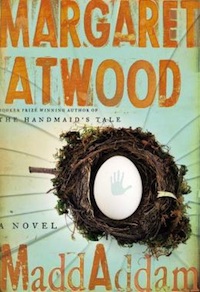Dystopian fiction might seem hot now thanks to The Hunger Games, Divergent, and other post-some-kind-of-cataclysm tales, but the subgenre is far more complex than a simple trend. And while Margaret Atwood doesn’t want you to call her a science fiction writer, she has been showing humanity how to get down in the muck of it for a good portion of her career. With the release of MaddAddam, Atwood is wrapping up a trilogy of sorts which began with 2003’s Oryx and Crake. What makes Maddadam and its previous installments so unique though is the way Atwood treats dystopia not just as a metaphor but as a real, complex, and ultimately human event.
Handily, you don’t have to have read either Oryx and Crake or The Year of the Flood to enjoy and/or comprehend what’s going down in MaddAddam. I’m not sure if this was Atwood’s idea or her editor’s; but the start of the book features a section called “The Story So Far” complete with quick synopses of each of the two previous books. Here you learn all about who Snowman/Jimmy is, what happened with the Flood, and are reminded that the genetically engineered giant pigs—known as pigoons—are fairly “crafty.” (Atwood’s use of this word in the introduction is one of the reasons I love her writing so much. The right words for the right emotions.) MaddAddam is complex and haunting enough without the knowledge of the other books, but fans of those will dig not only the continuity but also the refresher.
The narrative point-of-view is all over the place in this novel, making me shake my head in delight several times at just how many “rules” Margaret Atwood loves breaking. If she were in one of my writing workshops, I might say something like, “Hey, Maggie, I don’t know if this shifting perspective between all these characters is going to work.” But it does. Beautifully.
Ostensibly, MaddAddam is about a character named Toby, a young woman fortified up with a bunch of other human survivors at a compound where they are essentially just trying to get by as they wait for the return of former leader Adam One. Being stuck in the woods is an old-school storytelling device for a reason, and probably because it’s so effective. Having your characters isolated complete with creepy trees and survival problems is inherently exciting because it peels away layers of dull, safe, society. With quotidian efficiency, Atwood leaves no leaf unturned—or genetically engineered animal left behind—in describing just how these people get through their day.
The point-of-view switches exist because there are several stories inside of stories. The tale of Toby’s lover Zeb switches been a faux-present and past-tense and is intercut with the conversation between Zeb and Toby about what is going on “right now.” It’s not only effective, realistic, and creative, but it’s funny, too. The various point-of-view switches also serve as a kind of “chorus” in between the descriptions of the actual various narrative events. Further, super-ideal (and child-like humans) known as the “Crakers” are constantly singing, a fact which annoys several characters. The repetition from the regular humans of the phrase “please stop singing” made me laugh every single time.
In terms of plot, MaddAddam is all over the place, tantalizing you with one kind of story then leading you into another piece of backstory you could never have seen coming. Whenever I felt like a character or situation was abandoned for another direction the novel was taking, I instantly felt cheated. Why can’t we go back and see how Jimmy is doing? Do I want to hear about what Zeb was doing years ago? And yet, the book is a page-turner. Not in any kind of whodunit or adventure sort of way, but instead, thematically. There’s so much dehumanization (both literally and figuratively) throughout that the reader will probably be overwhelmed with how to feel about all of it. In the end is the struggle to improve, perfect and then preserve human life, even worth it? The idealized Crakers have no nuance or reflective thought, and yet they are happier than humans. How do we feel about that?
This is why I think MaddAddam is The Hunger Games for grown-ups. There’s no outward plot-themed conceit as to why all these people are in survival mode, instead it’s a fact of life. Sex exists and is both a positive thing and huge problem in this kind of environment. Atwood (as in the other books) uses the nomenclature of a ruined dystopian world to accentuate the best and worst parts of human beings and their creations. And while she’s almost recreationally denied being a science fiction writer, everything in this book seems possible. Atwood points this out in her epilogue too. This book isn’t just phoning in advanced biological science or gene-splicing for the fun of it. Margaret Atwood has done her homework!
You won’t always know who to root for in MaddAddam, nor will you be totally satisfied with the direction all the various plot turns take. But you will firmly believe Margaret Atwood is way smarter than you and possibly any other writer working in speculative fiction. Because if there is a master of dystopian fiction which illuminates not only scientific possibility, but also examines the human condition with unflinching and unbiased honesty, then that master is Margaret Atwood.
Ryan Britt is a longtime contributor to Tor.com and creator of the Genre in the Mainstream column.










